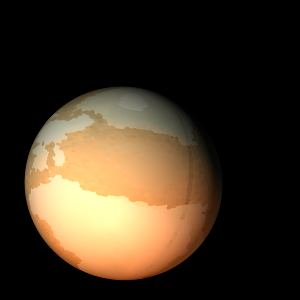|
|
Space Astro
|
Info for exoplanet "Ticarpa Mona"
| Scientific (actual) data |
|---|
| Name | K2-185 b |
| Planet status | Confirmed |
| Radius | 0.117 |
| Orbital period | 10.6166 |
| Inclination | 88.932 |
| Discovered | 2018 |
| Updated | 2021-02-05 |
| Tconj | 2457140 |
| Publication | Published in a refereed paper |
| Detection type | Primary Transit |
| Alternate names | 2MASS J08410232+1441250 b, EPIC 211611158 b, EPIC 211611158.01, WISE J084102.31+144124.8 b |
| Star name | K2-185 |
| Right ascension | 130.26° |
| Declination | 14.69° |
| Mag v | 12.21 |
| Mag j | 11.066 |
| Mag h | 10.749 |
| Mag k | 10.68 |
| Star distance | 268.357 |
| Star metallicity | -0.1 |
| Star mass | 0.96 |
| Star radius | 0.94 |
| Star sp type | G2V |
| Star temperature | 5788 |
| Star alternate names | 2MASS J08410232+1441250, EPIC 211611158, WISE J084102.31+144124.8 |
| Wikipedia article | K2-185 b |
Back
| |
| Fictional info (?) |
|---|
| Suggested name | Ticarpa Mona |
| Planet type | Cold planet |
|
| Estimated population | 80000000000 |
| Atmosphere | Water | 56% |
| Methane | 38% |
| Carbon dioxide | 4% |
| Oxygen | 0.5% |
| Atmospheric pressure | 0.4 bar |
 |
| Moon | Tania | Large almost round rocky moon |
| Uqsete Hoe | Medium-sized round ice moon |
| Phoeuan Loge | Small slightly egg-shaped rocky asteroid |
| Ymirtrin | Huge potato shaped crater-filled asteroid |
| Eupan | Medium-sized round rocky planetoid |
| Teaeuke Nomiahe | Small slightly egg-shaped gaseous moon |
| Steph'theal | Small slightly egg-shaped rocky asteroid |
| Lyke Daph | Large round gaseous moon |
| Deneculo Ariel | Small potato shaped ice planetoid |
| Hermisly | Medium-sized slightly egg-shaped ice planetoid |
| Dildeimedeia | Very small round crater-filled moon |
| Aittha Enbauti | Medium-sized slightly egg-shaped crater-filled moon |
| Logedaph | Very small almost round gaseous comet |
| Dusxi | Medium-sized potato shaped gaseous moon |
| Teus | Large almost round rocky planetoid |
| Farano-mavos | Large round gaseous planetoid |
| Gelrok'mathe | Small almost round gaseous moon |
| Tarvos He | Large round ice moon |
| Prolene-noetay | Very small round rocky moon |
| Eltur-ijicres | Medium-sized irregular ice asteroid |
| Harebeb-he | Huge irregular rocky comet |
| Nestelin-fran | Small slightly egg-shaped rocky moon |
| Fenforn Dahano Hi | Small potato shaped rocky asteroid |
| Google search for Ticarpa mona |
|
Website by Joachim Michaelis
|
|
|
|